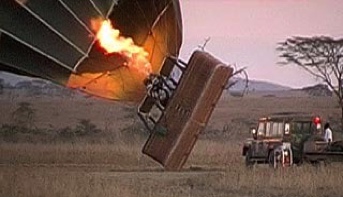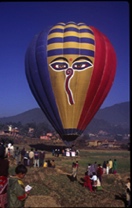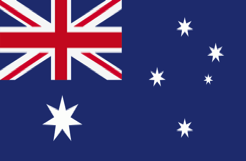
Silencing Professional Pilots.Com
By Capt Nigel Pogmore
Former pilot & safety officer
Serengeti Balloon Safaris Ltd
Becoming a hot air balloon pilot

With our area of operation in control air space (Kathmandu Valley), I was radio and transponder equipped.
I would climb to 10,000 feet AMSL. Taking in the view of the Annapurna range and Mount Everest was a daily pastime. Yes, I had to pinch myself; it doesn't get better than that.During each seven month season I would conduct approximately 100 flights.
For the five months, I was constantly on a tour, flying in Regina, Saskatoon, Swift Current (Ripley Creek!) Moose jaw, to name but a few places. No matter where I was flying, it all looked the same, as did the many Best Western motels and the menus!
I remember contacting Air Traffic Control, which I mistakenly thought I was flying in Saskatoon, where I'd been flying the previous day. "Saskatoon tower balloon Alpha Charlie Bravo requesting descent for landing. Tower acknowledgement:- "Alpha Charlie Bravo, Regina Tower,!!
Immediately realising my mistake, I apologised and received a comical response: “No worries, it all looks the same, mate. Setting humour aside, given that it takes more than a pilot to get any aircraft in the air, I've always felt that ATC officers, along with a variety of support crew, are the un-scene heroes of aviation.
Due to special-shaped balloons being so heavy and therefore having unusual flying characteristics, Pilots are never permitted to offer rides to fare-paying passengers; however, it is permissible to take nonpaying passengers on board, such as my ground crew. Another exception would be TV reporters, which I have done numerous times. The emphasis has been on non-commercial operations.
A treasured memory comes from being approached by an 86-year-old lady attempting to organise a balloon flight for her father, Mr Albert Anderson, who was to celebrate his 104 birthday. With the company's agreement came the day to fly this gentleman and his 86-year-old carer!
On their arrival at the launch site, I walked across to greet my two VIP passengers. Mr Anderson was wearing a cap with 102 written on it; assisted with a walking frame. As I apologise for getting his age wrong, there was a smile, slowly raising his right arm, pointing to his cap, in a low & croaky voice, “Old hat, helicopter ride two years ago”! I love it.
With numerous press and TV reporters all part of his entourage, it was inevitable that this would be on the news the following day, so no pressure then, thinking to myself, I better get this one right! Landing gently next to the road, everything went extremely well.
Pilots are very aware that we're only allowed to fly according to what is described as privileges contained within our licenses & qualifications; it was an enormous privilege to be involved in that special occasion. I am now thinking about it; I question whether my VIP passenger is the oldest man to fly in a balloon, a special shape at that!
TV coverage was far greater than any of us expected and lasted several days on numerous channels; it was not only broadcast on the news but also shows such as the Oprah Winfrey Show. One anchorman referred to me as an eccentric English pilot who lives in Nepal. Me an eccentric? I can live with that.

Unfortunately, with the ink of my recently acquired commercial pilot's licence still wet, Alice Springs produced what was to be for many years the world's worst hot air balloon accident. Two balloons collided at 4000 feet, killing 13 passengers, of whom were mainly Japanese; nobody survived. Tragic enough, just when you think it couldn't get any worse, there was more to come.
In 1996, while sitting in wintry York, I received a call from Chris . This was to offer me a position flying the only hot air balloon in Kathmandu/ Nepal; just before ending the call, with a chuckle, he informed me that he would give me three days to make up my mind.
Now, imagine combining my passion for the Himalayas now piloting a bloon in the Himalayas; I don’t need more than three seconds to decide. I spent three consecutive seasons, each of seven months. With our area of operation in control air space (Kathmandu Valley), I was radio and transponder equipped; I would climb to 10,000 feet AMSL. Taking in the view of the Annapurna range and Mount Everest was a daily pastime. Yes, I had to pinch myself; it doesn't get better than that. I would conduct approximately 100 flights each season. I soon became very much at home in Kathmandu.
1988/9 Whilst I didn’t realise it then, my introduction to commercial hot air balloons was at the highest level. Chris’s boundless enthusiasm his a larger-than-life character; however, he doesn't suffer fools. Everything was highly professional; the quality of equipment, attention to normal aviation practices and procedures passenger safety were 2nd to none.
Just weeks after that event, another balloon accident, this time in New South Wales, as the balloon flew into power lines. The veteran pilot Ross Spicer, along with one passenger, were killed; I recall that that accident took place on Wednesday. Situated not that far away in the vineyard area of the Hunter Valley, pilot examiner David Bowers, while soul-searching at his friend's loss, uttered, "How could Ross have done that? He was so experienced" However, 72 hours later, David and one of his passengers came to a similar fate on power lines. In the course of three months, a staggering 14 passengers and three pilots had lost their lives. As one could easily imagine, the Australian balloon industry was in shambles, leaving my prized commercial pilot’s license as good as it was worthless.
The Australian authorities, along with commercial operators, wasted no time taking a long, deep look at what had happened, immediately addressing many issues and resulting in rigorous reform. As a result, Australia has led the way in introducing some of the highest standards in the world since that time. At the time, very much respected professionals such as Hayden Wicks, a Qantas 747 check Captain /'commercial balloons pilot examiner, along with pilot examiner, Internationally awarded Chris Dewhirst, made it their business to ensure that I was not let loose before receiving additional oversight.
As well as attending many hours of in-depth lectures and hours spent analysing hypothetical situations, all as a result of these accidents, it was demanded that I also receive additional yet advanced flight training. With Hayden having the final say, rather than being subjected to the normal one-hour flight test, I was to quickly learn that the entire weekend would be consumed with test flights. Normal flying and extensive mock/induced emergency situations had to be dealt with with no errors. These included quickly identifying and rectifying the reason for fuel starvation, or indeed a leaky parachute, of that matter, the mysterious malfunctioning pilot light. The crescendo was to land the balloon on an examiner-assigned target; however, at the last moment and without any forewarning, I was to simulate the burner blast valve malfunctioning yet still land on the same target. The pressure was on.
These two professionals passed on invaluable insight, not only surrounding their flying skills but, most importantly, in adopting the appropriate attitude when assessing what is undeniably a potentially dangerous sport, as are all fields of aviation . Whilst it is true to say that none of us are ever exempt from accidents, it's advisable to accept that passenger safety starts on the ground, at the same time to acknowledge that regardless of time spent in the air, we never know it all, Piloting any aircraft be it balloon or a Boeing is a never-ending journey of learning.
Although I didn't realise it at the time, despite the Alice Springs carnage years later, after observing standards elsewhere (Egypt and Turkey come to mind), I would only then appreciate to be fact, that I was brought into commercial ballooning at the highest level. To this day, I remain immensely grateful to both Chris and Hayden for their invaluable insight. Years later, when leaving Australia, I thought those standards were the norm throughout the industry. Unfortunately, I soon learned that it was far from reality. For potential passengers, It’s a case of Russian roulette when choosing the right company to fly with.